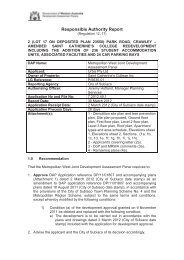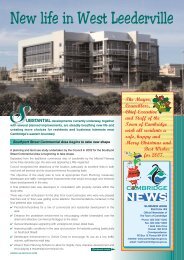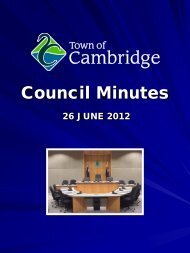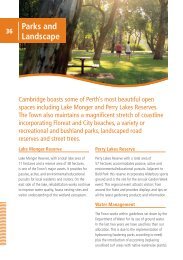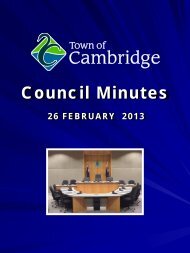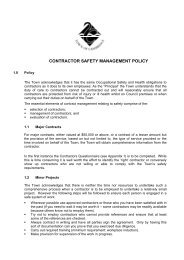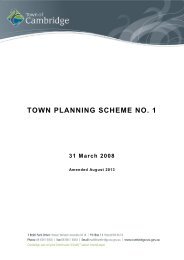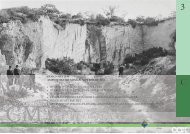Council Minutes - Town of Cambridge
Council Minutes - Town of Cambridge
Council Minutes - Town of Cambridge
You also want an ePaper? Increase the reach of your titles
YUMPU automatically turns print PDFs into web optimized ePapers that Google loves.
COUNCIL MINUTES<br />
TUESDAY 28 AUGUST 2012<br />
COMMENT:<br />
In the directions hearing the SAT member referred to three previous SAT cases where the<br />
reasonableness or fairness <strong>of</strong> conditions applied by local government authorities have been<br />
considered. The three cases that are regarded as examples in terms <strong>of</strong> the reasonableness<br />
<strong>of</strong> conditions are as follows:-<br />
• Baumgartner and City <strong>of</strong> Joondalup [2005] WASAT 234;<br />
• Kellett and <strong>Town</strong> <strong>of</strong> Vincent [2007] WASAT 155; &<br />
• Booth and <strong>Town</strong> <strong>of</strong> East Fremantle [2008] WASAT 155.<br />
In all three <strong>of</strong> these previous cases "The Newbury Tests" which are the recognised and<br />
established tests for the reasonableness and validity <strong>of</strong> a condition applied in a Planning<br />
Approval were referred to.<br />
In Western Australian Planning Commission v Temwood Holdings Pty Ltd (2004) 221<br />
CLR 30 at [57], McHugh J in the High Court <strong>of</strong> Australia endorsed the tests for the validity <strong>of</strong><br />
a condition <strong>of</strong> planning approval articulated by the House <strong>of</strong> Lords in Newbury District<br />
<strong>Council</strong> v Secretary <strong>of</strong> State for the Environment [1981] AC 578 in the following terms:<br />
"A condition attached to a grant <strong>of</strong> planning permission will not be valid therefore unless:<br />
(1) The condition is for a planning purpose and not for any ulterior purpose.<br />
(2) The condition reasonably and fairly relates to the development permitted.<br />
(3) The condition is not so unreasonable that no reasonable planning authority<br />
could have imposed it"<br />
The second Newbury test considers whether a condition reasonably and fairly relates to<br />
the approved development is applicable. As outlined by SAT in the above mentioned<br />
cases, there must be a nexus between the subject condition and the variations applied<br />
for. A condition <strong>of</strong> approval can be said to reasonably relate if it arises from changes<br />
precipitated by the development.<br />
In this case, the proposed works were located at the rear <strong>of</strong> the existing dwelling and <strong>of</strong>f<br />
the rear laneway. There were no works proposed to the original front portion <strong>of</strong> the<br />
traditional style home or within the front setback area. It can be said therefore, that the<br />
condition to remove or modify the existing solid front wall on St Leonards Avenue does<br />
not fairly or reasonably relate to the variations applied for and therefore fails to meet the<br />
second test for the validity <strong>of</strong> a condition as articulated above.<br />
POLICY/STATUTORY IMPLICATIONS:<br />
There are no policy or statutory implications related to this report. The proposal was<br />
assessed against the provisions <strong>of</strong> the Residential Design Codes (R Codes), <strong>Town</strong> Planning<br />
Scheme No.1, and the <strong>Town</strong> Planning Scheme Policy Manual.<br />
H:\CEO\GOV\COUNCIL MINUTES\12 MINUTES\AUGUST 2012\B DV.DOCX 63



